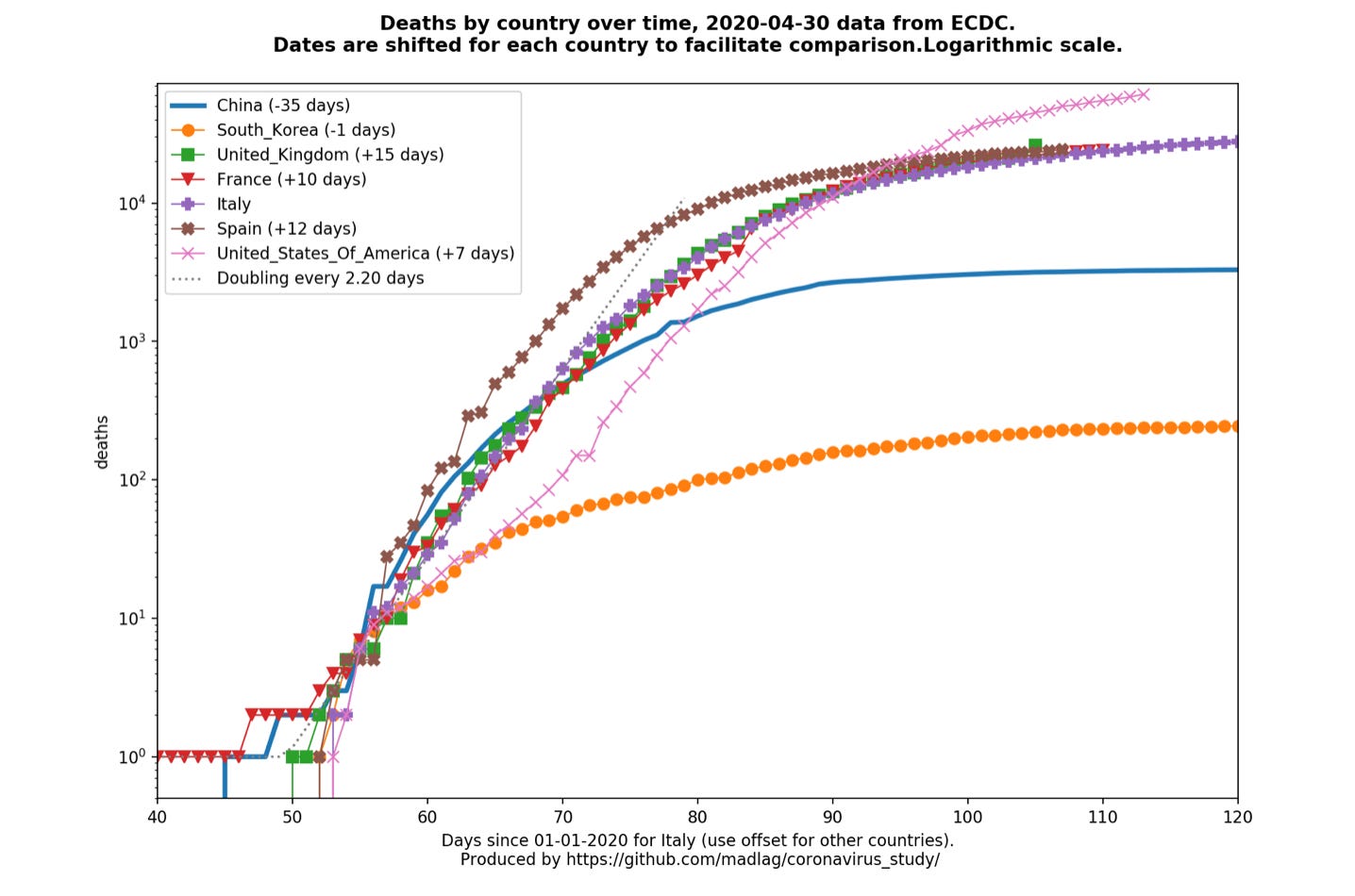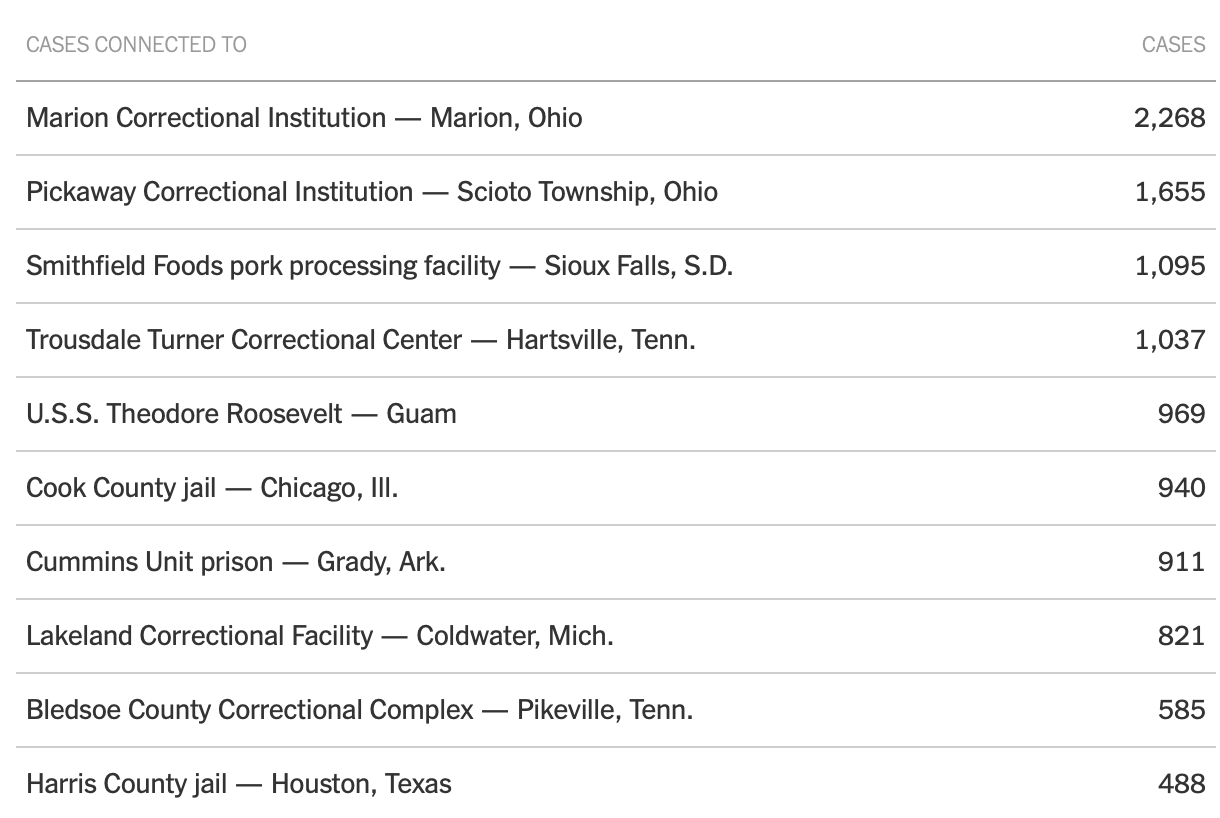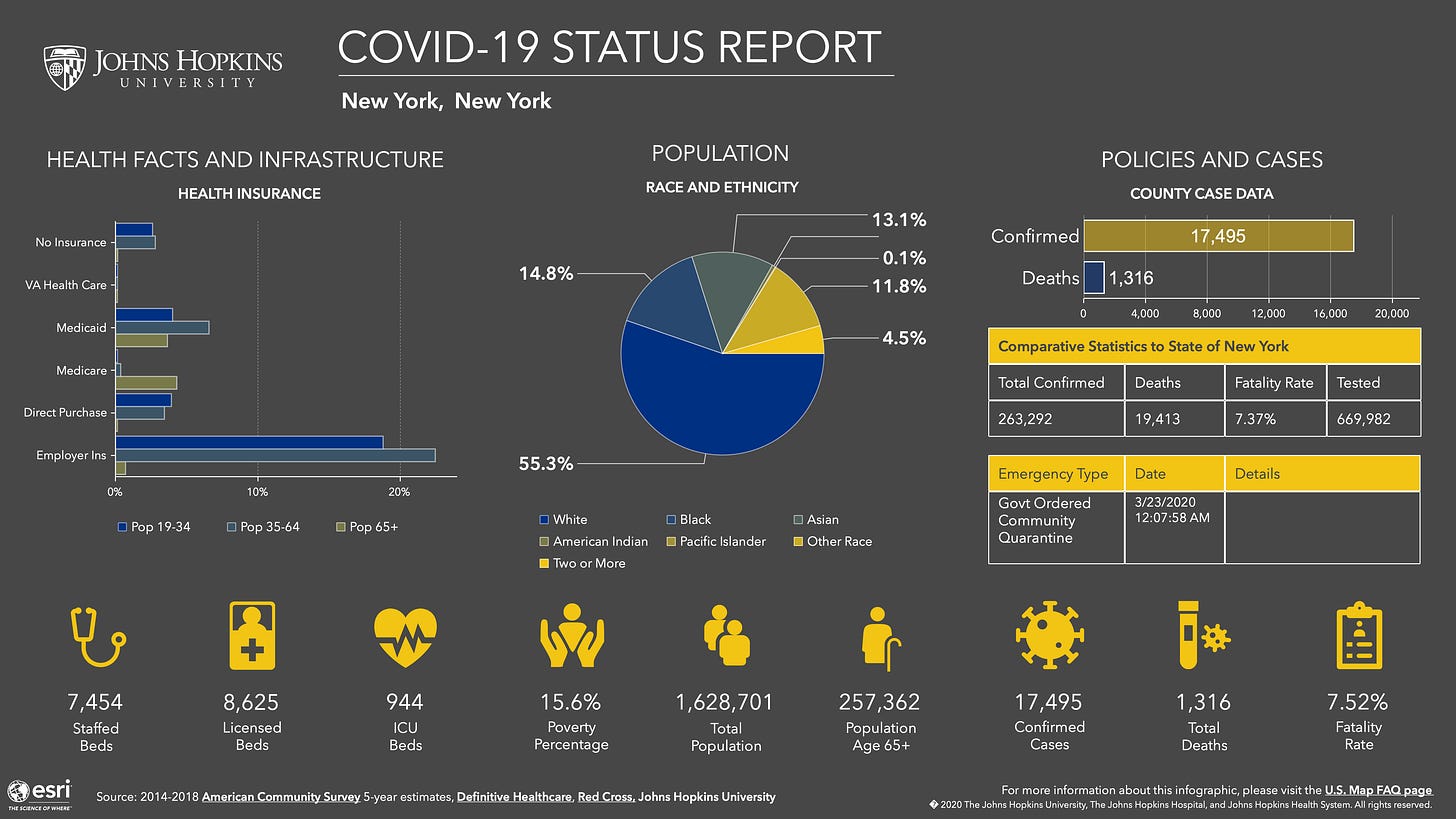🦠 COVID-19 | Telling the right stories
I am a scientist by education, banker at JPMorgan for a few years, then mature PhD student in Chemical Biology at Oxford under the supervision of Christofer Schofield (FRS) and Peter Ratcliffe (Nobel laureate in medicine in 2019). Founder and tech investor focusing on media and education. I care about science, learning and Democracy which are good bedfellows.
📊 Daily Data Brief:
3,392,718 (+88,578) cumulative cases
Active cases: 2,075,668 (+44,412) (this is the number of currently infected patients)
Total Deaths: 239,178 (+5,349)
Serious/Critical Cases: 51,332 50,962 (+370)
Recovered: 1,077,872 (+38,817)
Source: Worldometers
Death curves (updated daily as ECDC releases). Major update with per country graphs now available (Link) (US, UK, France, Germany, Sweden) (👈NEW❗️)

Today the Corona Daily attempts to tell the right stories.
The public or their public representatives might not support the right decisions if they are fed the wrong stories. As I have written before traditional media has its share of responsibility in the severity of the crisis. It is because of their failing that pre-eminent virologists like Christian Dorsten in Germany took time of his stellar academic work to start a podcast to the nation on NDR (37 episodes to this day with more than a million listening in) or that a non-epidemiologist, Zeynep Tufekci, ended up writing the first widely circulated Op-Ed on #Masks4all (“Why Telling People They Don’t Need Masks Backfired”).
The public has also shown, and it is also hoped that it will continue, more reason in the way it has conducted itself. In most countries or states, it has probably passed the marshmallow test better than its elected and/or authoritarian leaders including on some of the current and hastily decided re-openings. Sometimes it has even held off from ingesting more dangerous substance than marshmallows.
The media and the communities need to continue to feed the right stories to an intelligent public. Death focuses everybody’s mind. Today, the Corona Daily starts by an Op-Ed explaining why pursuing herd immunity as strategy rests on an untold fact and remains unconscionable given the viable alternatives. Meatpacking plans and vulnerable members of society come in focus in two excellents Twitter threads.
Remdesivir gets its emergency authorisation from the FDA, the CIDRAP maps 3 scenarios (spoiler: we are in for the long haul for each of them). A great article from privacy academics on what is wrong with the current accompanying law and version of the Australian contact tracing app.
Finally a wonderful read on the history and potentially final act of the office, and a great podcast on mass surveillance with Shoshana Zuboff.
🦠Article of the day: Carl T. Bergstrom (professor of biology at the University of Washington) and Dr. Natalie Dean (assistant professor of biostatistics at the University of Florida) write “What the Proponents of ‘Natural’ Herd Immunity Don’t Say” in the New York Times.
The “herd immunity as strategy” which was briefly considered in the UK (with sadly a resulting increased number of fatalities versus its Europeans neighbours) was thought to have been put to bed worldwide once even Downing Street abandoned it. However, as Sweden seems to be implementing it and paradoxically as lockdowns have shown their effectiveness, herd immunity is making a comeback. This is also due to the timing and uncertainty surrounding the production en masse of a vaccine, and the economic as well as mental health costs associated with the extended lockdowns.
As more epidemiologists, economists and others advocate it again, the authors argue that they seem to omit at least one critical fact which is also the subtitle of the article: “Try to reach it without a vaccine, and millions will die.” It is not only this fact which makes this strategy unconscionable:
“While this is an extraordinarily difficult virus to manage, countries such as New Zealand and Taiwan have had early success, challenging the narrative that control is impossible.”
Some observers would also add South Korea to that list. There is a known viable testing-tracing-isolating strategy to contain the pandemic. Accepting that our governments do not attempt to implementing it would irremediably and most likely fatally wound their legitimacy. The economic consequences and the resulting social unrest would be far more onerous and serious than a path where we give ourselves the time to save millions of lives and preserve the foundation of our socio-economic order.
It could be that continued incompetence from governments or unnecessary (or unacceptable) delays in putting in place a New Zealand strategy leads to social unrest. However, it does not seem to be a line of argument put forward by proponents of herd immunity as strategy and getting our government to act is part of the ethical path. (Link)
🍖 Threads of the day: Two great Twitter threads today who have in common their highlighting of meatpacking plants as underreported yet significant outbreak locations. The more often narrated and therefore known ones are prisons and nursing homes. Neff’s thread inspired the title of today’s Corona Daily. There are some real nugget tweets in both threads.
Thread 1: Gina Neff (Associate Professor in the Department of Sociology at Oxford) starts off by including a link in the New York Times to a list of the top outbreaks in the US. It showing the prominence of the three types of locations listed above. Included below is a picture of the Top 10 outbreaks:

Neff highlight (as does NA Christakis in his thread), the appalling “responsibility bonus” policy of Smithfield during a pandemic:

Neff’s main message is that COVID-19 affects the most vulnerable in society the hardest (not talking about co-morbidities but working conditions and ethnicity), and that not protecting the weakest and most marginalised affect ALL of society during a pandemic. (First tweet and Twitter thread)
Thread 2: Nicholas A. Christakis (Sterling Professor of Social & Natural Science at Yale) ( (First tweet and Twitter thread). Christakis focuses on meatpacking plants. Until one reads both threads one probably thought that besides healthcare workers, gig-economy workers and Amazon warehouse workers were the most vulnerable. Christakis theory about why these plants create these super spreader clusters is summarised in the last tweet:

🦠 Sharon Begley writes “Three potential futures for Covid-19: recurring small outbreaks, a monster wave, or a persistent crisis” for STAT news. The article is a summary of the equally readable report published by CIDRAP (Center for Infectious Diseases Research and Policy) and titled “COVID-19: The CIDRAP Viewpoint”.
It maps three scenarios for the pandemic drawn from past influenza epidemics.
Scenario 1: Peaks and Valleys. In this scenario the main (and current) peak is the highest and we have several smaller and sequential peaks to follow. There would likely be reinstatement of mitigation measures of various strength for the subsequent peaks.
Scenario 2: Fall Peak. The current Spring wave, will be followed by a much larger fall wave. This is similar to the 1918-19 Spanish Flu. In this scenario, there will most likely be a reinstatement in the fall of the strict lockdowns that most of the world is currently under.
Scenario 3: Slow Burn. This would be a new scenario with a pattern not seen from past influenza epidemics. It is unclear in this scenario whether we would have to go under lockdown again, although this would likely vary depending on geography.
All 3 scenarios, last 1-2 years and entail a rising death toll from COVID-19 and its subsequent strains. We are in these COVID-19 times for the long haul. (Link)
💊 Erika Edwards writes “FDA grants remdesivir emergency use authorization for COVID-19” for NBC News. An emergency use authorization (EUA) is not the same as FDA approval. The press release from the Food and Drug Administration specifies that administration of remdesivir is to treat adults and children hospitalized with “severe disease” defined as:
“Severe disease is defined as patients with low blood oxygen levels or needing oxygen therapy or more intensive breathing support such as a mechanical ventilator.”
It is likely that Gilead will try to extend the use of the drug beyond the current scope of its administration, even though Gilead CEO publicly stated that his company’s drug was “not a cure but a very significant treatment”. Clinical trials continue. (Link)
🏢 Catherine Nixey writes ‘Death of the office’ for 1843 (The Economist publication). This is a wonderful long read telling the history of the office.
It starts with “one of the world’s first offices – that of the East India Company in London” until the more recent Neumann’s WeWork. It looks at the office through cinema and cultural life, including through the eyes of the poets John Betjeman T.S. Eliot and Walt Whitman.
All these cultural references will be great to read or watch from home in between Zoom calls. I am convinced it must have been Nixey’s primary intent in inserting so many. A wonderful Saturday office requiem read. (Link)
🚔 Graham Greenleaf (Professor of Law & Information Systems) and Katharine Kemp (Senior Lecturer at the Faculty of Law) write “Australia's COVIDSafe App needs more legal protections and transparency to gain trust” for the University of New South Wales.
Australia has already launched its app alongside a Determination (a legislation) and has achieved 3 million downloads in less than a week. It is estimated that it has only reach a third of the download target for the app to be effective. The authors lay out three shortcomings with the app and the Determination which would likely need to be remedied to gain the trust of 6 million more Australians:
“misleading initial statements by the government about the operation of the app; insufficient transparency; and flaws in the protections in the Determination.”
This opinion piece should be read by any public authority looking to launch such an app within their jurisdiction, to maximise initial trust, wide adoption and ultimately success of the app. A great and valuable read for citizens and policy makers ahead of any democratic debate on the issue. (Link)
🎙 Podcasts of the day: The Real Story Podcast brings “Is mass surveillance here to stay” for the BBC (Link)
“Governments are deploying new technologies to fight coronavirus. But at what cost to privacy?
Shoshana Zuboff - Author of The Age of Surveillance Capitalism
Stephen Roberts - Fellow in global health policy at the London School of Economics
Yuan Yang - Beijing technology correspondent for the Financial Times”
📊 A picture is worth a thousand words: Global (🌎) and local (with relevant flag) visualisation and forecasting tool
🌎The Financial Times (NEW❗️visualisation) has a data tracking page which is in front of the paywall, looking at cases and fatality curves for selective countries and metropolitan areas/region. It is not as extensive as the Madlag link below, where you can see static as well as animated images for a greater number of individual countries. (Link)🇺🇸 The John Hopkins University resource center was the first one I used back in January they have now made available in their latest iteration a county by county dashboard in the US including information about health capacity, insurance coverage, ethnicity and age breakdown of the population (New York example below) (Link)

💊 The "Map of Hope" provides a geographical overview of planned, ongoing and completed clinical trials. It is put together with data from WHO Clinical Trials Search Portal by the Heidelberg Institute for Geoinformation technology. (Link)
🌍 MRC Centre for Global Infectious Disease Analysis started to publish weekly death estimates for countries (Link)
🇺🇸 The US Center for Disease Control and Surveillance (CDC) publishes “A Weekly Surveillance Summary of U.S. COVID-19 Activity” (Link)
Google has published a new website to “See how your community is moving around differently due to COVID-19”. They have a lot of data to do so… (Link)
🇺🇸Another valuable resource by Unacast ( a data company providing human mobility insights). Their “Social distancing scoreboard looks and compares (State by State and County by County), the change in mobility to prior to COVID19 (Link)
🌎 Country by Country Curves: This is a GitHub made by my friend Francois Lagunas. He has written a script to scrape deaths and number of cases in order to visualise the rate of growth on a logarithmic scale. Great resource (Link)
CityMapper has started to produce City Mobility Index to show how much a City is moving. This is a very good indicator of how well lockdowns are respected around the world: Barcelona (4% of city moving) at one end and St Petersburg at the other end (68% of city moving) for yesterday (Link)
🌎A great resource put together by Ben Kuhn and Yuri Vishnevsky. At a time when we need solidarity and cooperation, I prefer their subtitle “We need stronger measures, much faster” than their title. It’s a simulator on what case growth looks like depending on your community’s measures. Fantastic resource to stir communities and governments to action (Link)
🇩🇪 The COVID19 dashboard for Germany is one of the best around. (Link)
🌎A helpful guide by VOX of the “9 coronavirus pandemic charts everyone should see” (Link)
🌎Data and chart regularly updated by the Centre for the Mathematical Modelling of Infectious Diseases at the London School of Hygiene & Tropical Medicine. It maps the effective reproduction number (also known as R0) of COVID19. You want to get it below 1 as fast as possible to contain an epidemic. (Link to see charts and more data about your country)
🌎This is a great COVID19 Dashboard prepared by Andrzej Leszkiewicz. Andrzej has also written an introductory and explanatory blog for it (“Coronavirus disease (COVID-19) fatality rate: WHO and media vs logic and mathematics”). I particularly like the country comparison tab, which allows you to track and benchmark the curve of the epidemic (number of cases and deaths) in your country with that of another. Very well done and informative. (Link)
“Going Critical” by Kevin Simler is a detailed interacting essay talking about complex systems, the importance of understanding networks, modelling and how this applies to: memes, infectious diseases, herd immunity, wildfire, neutrons and culture. Must read (Link)
🏛 Notable tracking projects
💊“COVID-19 treatment and vaccine tracker”. This tracker contains an aggregation of publicly-available information from validated sourcesby the Milken Institute (Link)🏛Tariq Krim has started a COVID19 website tracking data about each government policy response to the pandemic (Link)
🏛Oxford COVID-19 Government Response Tracker (OxCGRT) was launched yesterday. Data is collected from public sources by a team of dozens of Oxford University students and staff from every part of the world. It also looks at stringency of the measures and plots stringency with case curves. A great initiative and resource (Link)
👩💻Mike Butcher (Editor at Large Techcrunch and founder of TechforUK), had refocused TechforUK on the fight against COVID19. It is a very effective hands-on team of volunteer. Do reach out to them. He has also teamed up with We are now working closely with the volunteers behind the “Coronavirus Tech Handbook”. (They are ‘cousins’ of ours who originally created the Electiontechhandbook). Volunteer collaboration at its best! (Link)
📰 Cronycle resource:
Cronycle has made available a number of open-access feeds on its website which I extensively use for the Corona Daily. The four first feeds are:
1. COVID-19 General (Link)
2. COVID-19 x Resilience (Link)
3. Gig Economy x COVID-19 (Link)
NEW❗️Human Challenge Trials x Covid-19 (Link)
5. Supply Chain x COVID-19 (Link)
Human Rights x COVID-19 (Link)



